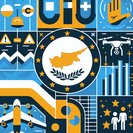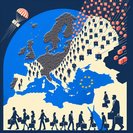
Visiting Ankara on 13 November, newly elected Turkish-Cypriot leader Tufan Erhurman and Turkish President Recep Tayyip Erdogan declared that a two-state settlement remains, in their view, the only realistic path to resolving the island’s 51-year division. While largely a political statement, the remarks come as UN envoys quietly explore confidence-building steps—such as additional Green-Line crossing points and joint management of hydrocarbons—that would directly affect cross-border movement of people and goods.
Erdogan argued that past federal-solution talks had “led nowhere” and accused the Greek-Cypriot side of seeking to “reduce Turkish Cypriots to a minority status”. Erhurman, however, signalled some openness to a UN-backed federation provided lessons are learned from past failures. Diplomats in Nicosia interpret the mixed messaging as tactical positioning ahead of an expected UN informal summit early next year.
![Erdogan Reiterates Two-State Cyprus Vision, Raising Questions Over Future Green-Line Mobility]()
For mobility planners, the political rhetoric matters because the number of daily crossings over the UN-patrolled buffer zone has rebounded to pre-pandemic levels—about 10 000 people each weekday—fuelled by Turkish-Cypriot workers commuting to construction and hospitality jobs in the south. Business chambers on both sides fear that hardening positions could stall planned upgrades, including a new pedestrian crossing at Pyla and digital pre-clearance for EU nationals driving rental cars north.
If talks remain frozen, Cyprus may expand unilateral measures it introduced in July—QR-code entry slips, spot customs checks on parcels and stricter rules for non-EU passport holders crossing from north to south. Conversely, a breakthrough could create a shared customs regime that simplifies logistics for companies operating island-wide.
Global-mobility teams with staff stationed in Nicosia should therefore monitor the political temperature and maintain contingency plans: dual insurance coverage for vehicles crossing the buffer zone, alternative commuting routes via Larnaca, and updated advice on passport stamps that could complicate future Schengen travel.
Erdogan argued that past federal-solution talks had “led nowhere” and accused the Greek-Cypriot side of seeking to “reduce Turkish Cypriots to a minority status”. Erhurman, however, signalled some openness to a UN-backed federation provided lessons are learned from past failures. Diplomats in Nicosia interpret the mixed messaging as tactical positioning ahead of an expected UN informal summit early next year.

For mobility planners, the political rhetoric matters because the number of daily crossings over the UN-patrolled buffer zone has rebounded to pre-pandemic levels—about 10 000 people each weekday—fuelled by Turkish-Cypriot workers commuting to construction and hospitality jobs in the south. Business chambers on both sides fear that hardening positions could stall planned upgrades, including a new pedestrian crossing at Pyla and digital pre-clearance for EU nationals driving rental cars north.
If talks remain frozen, Cyprus may expand unilateral measures it introduced in July—QR-code entry slips, spot customs checks on parcels and stricter rules for non-EU passport holders crossing from north to south. Conversely, a breakthrough could create a shared customs regime that simplifies logistics for companies operating island-wide.
Global-mobility teams with staff stationed in Nicosia should therefore monitor the political temperature and maintain contingency plans: dual insurance coverage for vehicles crossing the buffer zone, alternative commuting routes via Larnaca, and updated advice on passport stamps that could complicate future Schengen travel.









